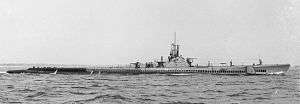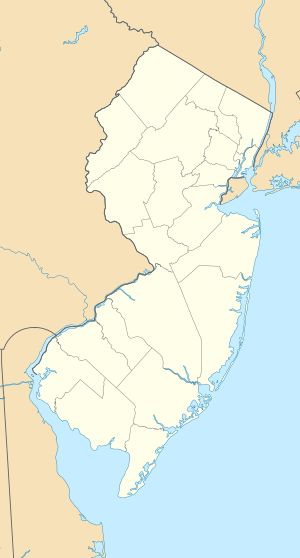USS Ling (SS-297)
 USS Ling (SS-297), wearing camouflage paint scheme in July 1945, during sea trials. | |
| History | |
|---|---|
| Namesake: | Ling, Fish |
| Builder: | Cramp Shipbuilding Company, Philadelphia, Pennsylvania / Brooklyn Navy Yard, Brooklyn, New York[1] |
| Laid down: | 2 November 1942[2] |
| Launched: | 15 August 1943[2] |
| Commissioned: | 8 June 1945[2] |
| Decommissioned: | 26 October 1946[2] |
| Struck: | 1 December 1971 |
| Honours and awards: | 1 Battle Star |
| Status: | Museum ship at New Jersey Naval Museum, Hackensack, New Jersey since 28 June 1972[1] |
| General characteristics | |
| Class and type: | Balao-class diesel-electric submarine[1] |
| Displacement: | |
| Length: | 311 ft 8 in (95.00 m)[1] |
| Beam: | 27 ft 3 in (8.31 m)[1] |
| Draft: | 16 ft 10 in (5.13 m) maximum[1] |
| Propulsion: |
|
| Speed: | |
| Range: | 11,000 nm (20,000 km) surfaced at 10 knots (19 km/h)[6] |
| Endurance: |
|
| Test depth: | 400 ft (120 m)[6] |
| Complement: | 10 officers, 70–71 enlisted[6] |
| Armament: |
|
|
U.S.S. LING | |
 | |
   | |
| Location | Hackensack River at 150 River Street, Hackensack, New Jersey |
|---|---|
| Coordinates | 40°52′47″N 74°2′26″W / 40.87972°N 74.04056°WCoordinates: 40°52′47″N 74°2′26″W / 40.87972°N 74.04056°W |
| Area | less than one acre |
| Built | 1945 |
| Architect | Cramp,William & Sons |
| Architectural style | BALAO Class |
| NRHP Reference # | 78001736[7] |
| NJRHP # | 525 |
| Significant dates | |
| Added to NRHP | 19 October 1978 |
| Designated NJRHP | 16 January 1978 |
USS Ling (SS/AGSS/IXSS-297) is a Balao-class submarine of the United States Navy, named for the ling fish, also known as the cobia. The ship is docked (since 1972) at the New Jersey Naval Museum in Hackensack, New Jersey and has guided tours available to the public.
History
Ling was laid down 2 November 1942 by the Cramp Shipbuilding Company of Philadelphia. She was launched 15 August 1943, sponsored by Mrs. E. J. Foy, and was moved to the Boston Navy Yard for completion and testing. Ling was commissioned on 8 June 1945, with Commander George Garvie Molumphy in command.
After shakedown and further installations, Ling headed out to sea to test her equipment 15 September 1945. The submarine based at Naval Submarine Base New London in Connecticut until she sailed 11 February 1946 for the Panama Canal Zone, arriving eight days later. She operated out of Panama until 9 March when she sailed north. She completed inactivation 23 October at New London, decommissioned 26 October 1946, and entered the Atlantic Reserve Fleet.
In March 1960, Ling was towed to Brooklyn, New York, where she was converted into a training ship at the Brooklyn Navy Yard, simulating all aspects of submarine operations. She was reclassified an Auxiliary Submarine (AGSS-297) in 1962.
Ling received one battle star for World War II service. Ling was reclassified a Miscellaneous Unclassified Submarine (IXSS-297), and struck from the Naval Register, 1 December 1971.
Museum ship
Six months later the old 297 was donated to the Submarine Memorial Association, a non-profit organization formed in 1972 with the purpose of saving Ling from the scrap yard. They petitioned the Navy to bring the boat to Hackensack, New Jersey to serve as a memorial "...to perpetuate the memory of our shipmates who gave their lives in the pursuit of their duties while serving their country". Many citizens and corporations contributed time, professional services, and funds toward the restoration of Ling. She arrived at her present home in New Jersey in January 1973, where she has been restored to near-mint condition—scrubbed, painted, and polished for public tours—through the efforts of the association. The compartments have been refurbished and outfitted with authentic gear that recreates the bygone era of the World War II battle submarine. She is now the centerpiece of the New Jersey Naval Museum at 78 River St., Hackensack, New Jersey.
X-rays showed that the submarine's five safes contained documents and metallic objects, but the combinations had long been lost. On 27 January 2006, Jeff Sitar, the eight-time world champion locksmith, opened the safes using only his fingers and an electronic sound amplifier, rather than drills or explosives. In the safes, he found a wide variety of objects, including a dozen pennies, two .45-caliber bullets, a ring of keys, many training and maintenance manuals and parts catalogs from the 1940s and 1950s, and two one-quart cans of 190-proof ethanol. (Despite the inevitable jokes that it was the private stash of the yeoman, the alcohol would have been used for cleaning electrical contacts.)[8]
In the American-produced Russian language film Katya shot in 2010, the Ling was used for a set to depict the Soviet K-129 diesel-electric powered submarine which sank on 8 March 1968 northwest of Oahu.[9]
In 2012, Seth Weiner, a Museum Studies scholar at Seton Hall University, published a thesis entitled Save our Ships: The Viability of Naval Vessels as Museum Exhibitions. The purpose of the work was to examine the common issues faced by Museums with warships as major exhibitions in an attempt to further the goal of better preserving the history of the United States Navy. USS Ling served as the primary case study.[10]
Site
Since 1972, the New Jersey Naval Museum had paid one dollar per year to rent its riverside site for Ling. In January 2007, the North Jersey Media Group, owner of the site, informed the museum that the site was going to be sold for redevelopment within the year and that the museum and submarine would need to be relocated.[11] Nevertheless, the museum remains in operation at the same site as of 2012. Update Sept 2013: the museum itself is closed due to damage in 2012 from Hurricane Sandy. The museum closed again for emergency repairs in late July, 2015.
Freshwater flow in the Hackensack has been considerably altered by the Oradell Dam.[12] The river has only been channelized to a point at the Riverbend in Hudson County.[13] The accumulation of silt affords navigation only for small boats.[14] The fate of the Ling may ultimately be connected to the ability for it to be moved from its location.[15][16]
The Court Street Bridge, just downstream of the museum, is the most upstream bridge over the Hackensack River required by federal regulations to open on request.[17] In 1999, the Code of Federal Regulations regarding bridge openings were changed at the request of Bergen County that it be required to open within four hours of a request, which had not occurred since 1994.[18] The decision to re-build the bridge with an operable swing span was a matter of controversy.[14]
See also
References
- 1 2 3 4 5 6 7 8 Bauer, K. Jack; Roberts, Stephen S. (1991). Register of Ships of the U.S. Navy, 1775–1990: Major Combatants. Westport, Connecticut: Greenwood Press. pp. 275–280. ISBN 0-313-26202-0.
- 1 2 3 4 Friedman, Norman (1995). U.S. Submarines Through 1945: An Illustrated Design History. Annapolis, Maryland: United States Naval Institute. pp. 285–304. ISBN 1-55750-263-3.
- 1 2 3 4 5 Bauer, K. Jack; Roberts, Stephen S. (1991). Register of Ships of the U.S. Navy, 1775–1990: Major Combatants. Westport, Connecticut: Greenwood Press. pp. 271–280. ISBN 978-0-313-26202-9.
- ↑ U.S. Submarines Through 1945 pp. 261–263
- 1 2 3 U.S. Submarines Through 1945 pp. 305–311
- 1 2 3 4 5 6 U.S. Submarines Through 1945 pp. 305–311
- ↑ National Park Service (2009-03-13). "National Register Information System". National Register of Historic Places. National Park Service.
- ↑ Jeff Sitar and Basil Kio speak about opening five safes on a World War II submarine, LexisNexis transcript of The Today Show, 28 January 2006
- ↑ Coutros, Yvonne (24 October 2010), "USS Ling in Hackensack is setting for movie about doomed Soviet sub", The Record, retrieved 2012-10-20
- ↑ Seth, Weiner, (2012-01-01). "Save Our Ships: The Viability of Naval Vessels as Museum Exhibitions". Seton Hall University.
- ↑ Holl, John. "Retired Submarine, 63, Seeks Loving New Home", The New York Times, 11 February 2007. Accessed 21 October 2007.
- ↑ Newark Bay/Hackensack River/Passaic River Study Area Report (PDF). Hudson-Raritan Estuary Environmental Restoration Feasibility (Report). United States Army Corps of Engineers. June 2004. Retrieved 2012-10-21.
- ↑ Newark Bay, Hackensack and Passaic Rivers – Hackensack River, New Jersey (PDF). Report of Channel Conditions 100 to 400 Feet Wide (ER 1130-2-306) (Report). 18 April 2011. Retrieved 2012-10-21.
- 1 2 Kelly, Mike (12 August 2012), "The bridge that may never swing Kelly: The bridge that may never swing", The Record, retrieved 2012-10-21
- ↑ Holl, John (11 February 2007). "Retired Submarine, 63, Seeks Loving New Home". The New York Times. Retrieved 2012-10-21.
- ↑ FER. "The sad sub in the Hack". Submarine Museums. Retrieved 2012-10-21.
- ↑ "117.723 Hackensack River", Title 33: Navigation and Navigable Waters Part 117—Drawbridge Operations Regulations, US Government Printing Office, 20 October 2012, retrieved 2012-10-20
- ↑ "Coast Guard 33 CFR Part 117 Drawbridge Operation Regulations: Hackensack River, Passaic River, NJ" (PDF). Code of Federal Regulations Title 33 – Navigation and Navigable Waters Volume: 1. Government Publishing Office. 11 November 1999. Retrieved 2012-08-21.
- This article incorporates text from the public domain Dictionary of American Naval Fighting Ships. The entries can be found here and here.
External links
- Photo gallery of Ling at NavSource Naval History
- New Jersey Naval Museum website
- USS Ling (SS-297) at Historic Naval Ships Association